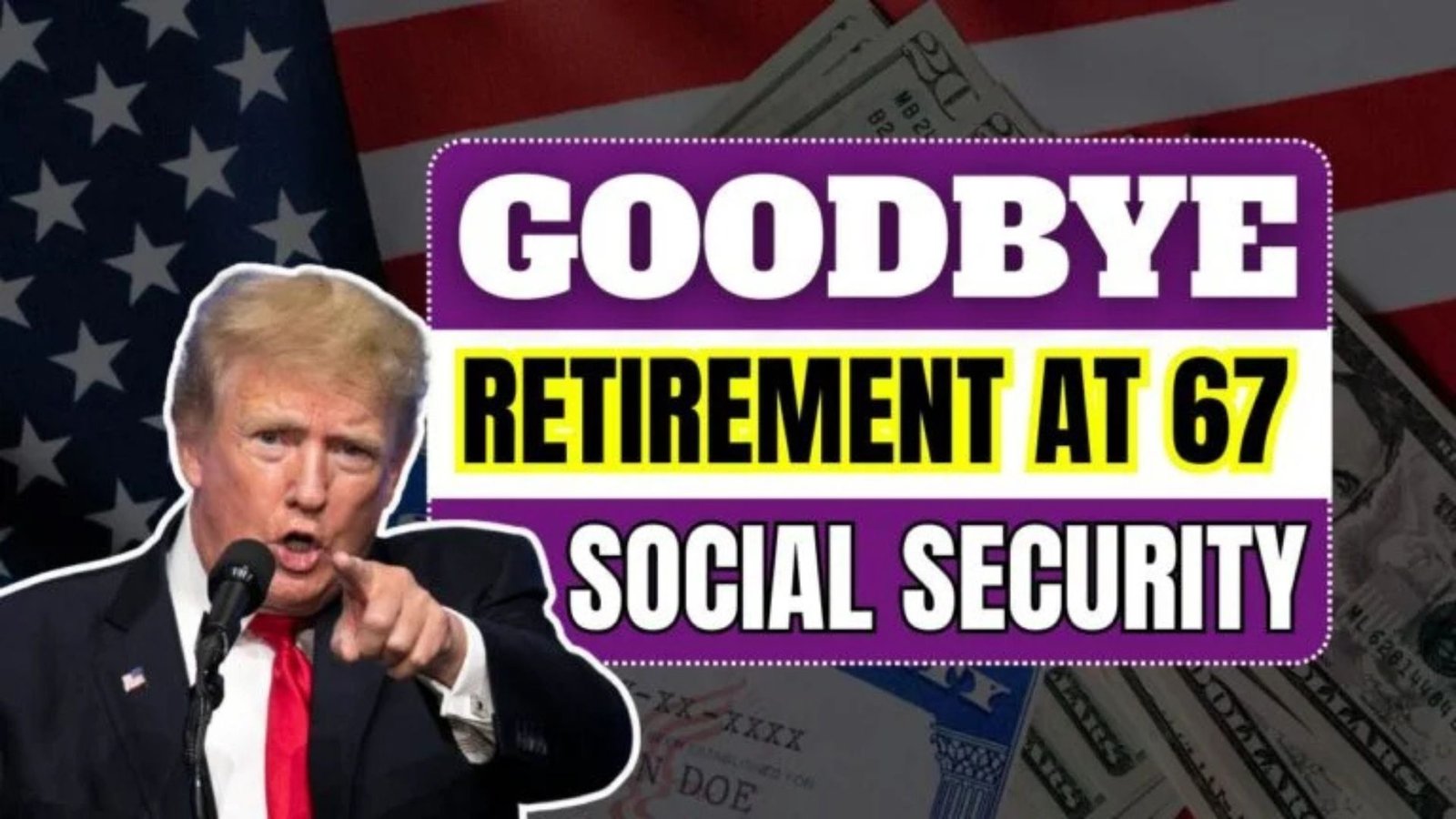In today’s fast-changing world, the old idea of hanging up your work boots at age 65 or 67 feels like a dream from the past. People are living longer, prices are climbing higher, jobs keep shifting, and money worries are everywhere. This has many folks scratching their heads about when to really step away from the daily grind. But with the latest tweaks to Social Security rules kicking in during 2025, it’s time to rethink your plans. Don’t let a government-set age control your golden years – learn how to take charge and retire on your terms, even if it means waving goodbye to retirement at 67.
This guide breaks it all down in plain English. We’ll cover why retirement age is shifting, what it means for your wallet, and smart steps to beat the system. Plus, we’ve got a handy table to spot the changes at a glance. Stick around – by the end, you’ll have tools to build a secure future without working an extra day longer than you want.
Why the Traditional Retirement Dream Is Fading Away
Picture this: Back in the day, turning 65 meant kicking back with a steady paycheck from your pension and enjoying lazy afternoons. It was the classic American story – work hard, then relax. But life isn’t that simple anymore.
Rising prices (that’s inflation for you) mean your savings don’t stretch as far. Medical bills are skyrocketing, and the Social Security fund is under huge pressure from more retirees and fewer workers paying in. Add in longer life expectancies – folks now live well into their 80s or 90s – and suddenly, retiring at the old retirement age just doesn’t add up. It’s not realistic anymore.
These shifts aren’t just numbers on a page; they’re changing how we live. Some see working longer as a way to ease money troubles, but others feel it’s stealing precious time from family and hobbies. The big question? What does retirement even look like in 2025 and beyond?
Big 2025 Changes: What’s New with Social Security Retirement Age?
Hold on tight – the rules are updating, and it could shake up your plans. The Full Retirement Age (FRA) is the point when you can claim your full Social Security benefits without any cuts. It’s not a one-size-fits-all number; it depends on when you were born.
Thanks to updates from the Social Security Administration (SSA), the retirement age is creeping up bit by bit. This started way back in 1983 with laws aimed at keeping the system solvent – basically, making sure there’s enough cash to pay everyone. Over nearly 40 years, they’ve nudged it from 65 toward 67 to spread out the load.
For 2025, if you were born in 1959, your FRA jumps to 66 years and 10 months. That’s two extra months of waiting compared to those born in 1958, whose FRA is 66 years and 8 months. Claim early? You’ll get less each month. Wait past it? You might earn bonus payments. Either way, this tiny shift packs a punch for your budget and lifestyle.
To make it crystal clear, check out this quick table breaking down the key Social Security retirement age updates:
| Birth Year | Full Retirement Age (FRA) | When It Starts | Key Impact |
|---|---|---|---|
| 1958 | 66 years and 8 months | 2024 | Two months earlier than 1959 group; easier transition for some. |
| 1959 | 66 years and 10 months | 2025 | Wait longer for full benefits; plan for delayed income. |
| 1960+ | 67 | 2027+ | Full phase-in; expect ongoing tweaks. |
| Future Talk | Possibly 68 or 69 | TBD | Debates ongoing; stay flexible in savings. |
This table shows how the retirement age ladder is climbing. (Source: SSA guidelines). It’s a wake-up call: Start planning now to avoid surprises.
How These Changes Hit Folks Born in 1959 – And What to Do Next
If you’re in the 1959 club, congrats – you’re hitting this update head-on in 2025. That extra two-month wait means smaller checks if you jump the gun, or a stronger payout if you hold out. But it’s more than math; it’s about real life. Will you delay that dream vacation? Stretch your savings thinner?
The good news? You don’t have to grind until 67. Many Americans are ditching the “wait-and-see” game for bold moves. Early retirement is still possible with some clever tweaks. Let’s dive into practical tips that keep your freedom intact.
Proven Ways to Retire Early and Dodge the 67 Trap
Who says you must clock in until retirement at 67? Beat the system with these easy-to-follow strategies. They’re designed for real people – no fancy degrees needed.
Ease Into Freedom: Cut Back Your Work Hours Smartly
Quitting cold turkey sounds great, but easing off works better. Drop to part-time and keep some cash flowing without the full-time burnout.
- Work just 10-15 hours a week to handle basics like bills, food, and doctor visits. It slashes stress on your nest egg.
- Big chains like Costco or Home Depot hook you up with health coverage even at 20-28 hours. That’s income plus peace of mind – no dipping into savings for meds.
Stockpile Cash: Your Safety Net for the Long Haul
Nothing screams security like a fat emergency fund. Aim high to cover those “what if” moments.
- Stash 18-24 months of living costs in a simple savings account. It’s your buffer against job dips or surprise expenses.
- Pro tip: Automate transfers from your paycheck. Small habits build big buffers fast.
Unlock Easy Money: Passive Income from Your Pad
Got spare space? Turn it into a cash machine without lifting a finger daily.
- Rent a room on platforms like Airbnb for $700-$1,000 a month. It’s steady dough while you sip coffee on the porch.
- Even a parking spot can net $150-$300 monthly in busy areas. Low effort, high reward – perfect for early retirees.
These hacks aren’t pie-in-the-sky; they’re tested by thousands navigating the new retirement age rules.
Tax Hacks and Health Wins: Keep More Money in Your Pocket
Taxes and doctor bills can gobble up your plans faster than you think. Play it smart to stay ahead.
First, withdrawals matter. Pull from everyday investment accounts before raiding your 401(k) or traditional IRA – it dodges big tax hits. A Roth IRA? Goldmine for early birds. Yank out what you put in anytime, tax-free. Sweet deal.
Health coverage pre-65 is the real beast. Keep your yearly income low (think Modified Adjusted Gross Income, or MAGI) to snag discounts via the Affordable Care Act (ACA). That could slash premiums by hundreds monthly. Pair it with part-time perks, and you’re golden.
Will Retirement Age Climb Even Higher? Get Ready Just in Case
The climb to 67 is wrapping up, but whispers in Washington point to 68 or 69 next. No laws yet, but talks are heating up. Why? Same old story: Longer lives, fewer workers funding the pot.
Don’t panic – adapt. Beef up that cash pile, mix your investments (spread ’em out to lower risks), and map withdrawal plans. Flexibility is your superpower in this shifting game.
Claim Your Retirement: Make It Yours, Not the Government’s
These FRA nudges might seem small, but they ripple through your life – from beach days to grandkid time. The fix? Craft a custom roadmap. Taper your workload, stack savings, weave in side hustles, and wield tax smarts like a pro.
Retirement at 67? Not if you play your cards right. Start today: Chat with a free SSA counselor at ssa.gov or crunch numbers in their online tools. Your future self will thank you. What’s your first move – a savings boost or a room rental ad? Drop a comment below!
Quick FAQs on Social Security Retirement Age Changes
Q: What’s the 2025 FRA for 1959 babies?
A: 66 years and 10 months – two months more than before.
Q: Can I still retire early?
A: Absolutely, but expect trimmed benefits. Use our tips to bridge the gap.
Q: Why the age hike?
A: To keep Social Security afloat, per 1983 rules.
Q: Future increases coming?
A: Maybe to 68/69 – watch the news and stay nimble.
Q: Best early retirement trick?
A: Build that 18-24 month cash reserve and add passive income streams.



